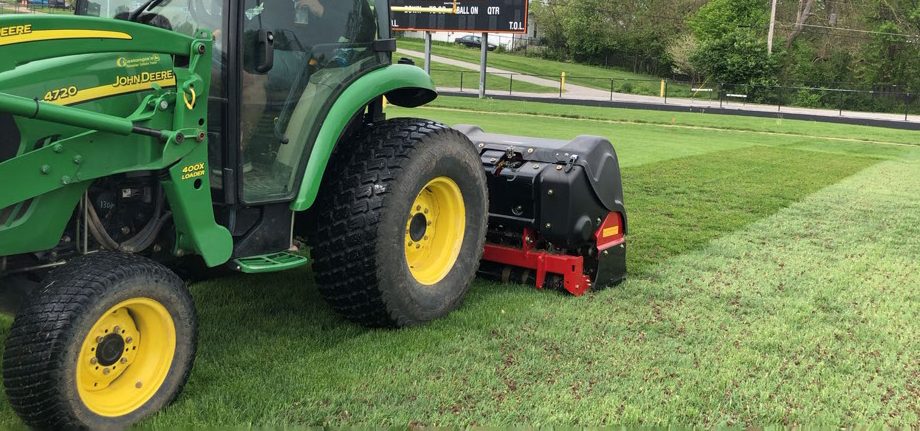Cool-Season Sports Turf: Fall Aerification and Seeding

Aerification and seeding are kind of like macaroni and cheese. Good by themselves, but so much better together! Aside from mowing and a balanced fertility program, aerification and seeding are the two most basic operations required to successfully manage established sports fields. Ideally, some type of hollow-tine aerification will precede seeding so that the rootzone mix, whether it is sand, native soil, or a modification, can easily make contact with the seed. Good seed-to-soil contact is the fundamental objective any time you are seeding. And, in the fall, it is critical to get germination and enough maturity from the grass plant so that it can survive the winter.
Species Selection
Kentucky bluegrass (KBG), perennial ryegrass (PRG), and turf-type tall fescue (TTTF) are the cool-season species suited for sports fields. Kentucky bluegrass is the king of sports turf for its traffic tolerance, shear strength, appearance, and other excellent qualities with one big caveat: when it is mature. Given that it is slow to germinate and the seedlings are not traffic tolerant, KBG is best introduced when traffic is low and seedlings have time to mature. KBG seed will continue to germinate when soil temps drop into the 50’s which is an advantage in the fall. Barenbrug HGT and Mountainview 365SS are continually top NTEP performers and are available either alone or as part of a blend.
Perennial ryegrass definitely meets expectations in appearance and texture, but its standout advantage is super-fast germination and seedling durability in traffic where it exceeds all other species. PRG prefers soil temperatures closer to 60 degrees for germination so the window for seeding is not as long as KBG in the fall. Sunrye GLS coated with XCD or Turfstar RPR are stand out perennial ryegrass choices.
Turf type tall fescue is somewhere in the middle of KBG and PRG for germination speed and seedling durability in traffic, but it needs soil temps around 60 degrees to germinate. So, timing is the same as perennial ryegrass. TTTF has improved dramatically in appearance and blends well with KBG or PRG but makes a name for itself on low maintenance or un-irrigated athletic fields. It is incredibly resistant to drought and performs well with low fertility inputs. For an expanded explanation of choosing seed and rates, this OSU publication a top-notch reference.
Aerification
Hold up your fingers like you are showing someone the number four. That is the size, spacing, and depth of hollow-tine aerification holes to use as a good rule-of-thumb. Relief of compaction, especially on native soil athletic fields, is the primary reason to aerify but a season-long aerification program that combines deep tine, solid tine, or other methods of disruption on a planned interval is ideal. For the purposes of fall seeding, aggressive hollow tine aerification produces the best opportunity to get seed in contact with soil.
Once the cores are pulled is the point where sports turf managers diverge based on the expectation of their athletes or coaches and the amount of time before the field must go back in play. Will you harvest the cores, slit seed, and topdress? Or do you have a limited staff that only allows you to drag the cores and broadcast spread your seed? High school and municipal fields often fall into the latter category, but the objective remains the same: select the right seed and get it in contact with the soil when the temperature will favor germination.
Dormant Seeding
Fall sports seasons often go well into October or November and the opportunity for a full-scale aerification and seeding operation is simply not feasible until the season is finished. Dormant seeding is a viable option to get ahead of the curve going into spring but is often poorly executed. The key is to avoid seed germination in the late fall. Young seedlings that germinate in November or December have very little chance of making it through the winter. The correct window for dormant seeding is when the soil temperature is above freezing and usually around 40 degrees. Kentucky bluegrass is the seed of choice as it overwinters well and will germinate at lower temperatures and earlier in the spring than PRG or TTTF. However, it is normal to expect early spring germination rates of only about 50%. Installing the seed with a slit seeder or pairing the operation with aerification will yield better results since the seed can be somewhat protected by a soil covering. Dormant seeding, even with its pitfalls, is still a good option because early spring aerification and seeding are often hampered by wet conditions that prevent equipment from getting on fields and competition from weeds like crabgrass.
Talk to your ATS rep today to plan for fall aerification and seeding!
Rebecca Auchter, CSFM
Sports Turf Specialist







